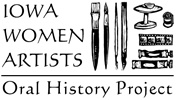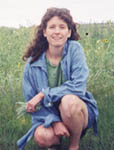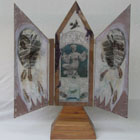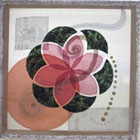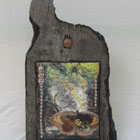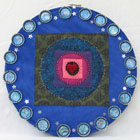LAURA WALDO-SEMKEN
artwork | audio | statement | 2008 update
artwork
audio 
(see also Making Art in Iowa)
- Child art (42 sec. | 289KB): listen | read
- College prof (35 sec. | 241KB): listen | read
- Artwork (53 sec. | 365KB): listen | read
- Life & nature (26 sec. | 176KB): listen | read
- Process (51 sec. | 350KB): listen | read
- Advice (56 sec. | 387KB): listen | read
artist statement
A hummingbird lands on my clothesline and looks right at me. A cloud is showing me stories about change and I am listening to the history of the Earth recorded in the river rocks from my driveway. Nature is living passionately in my backyard. Now two dancing hummingbirds have appeared. They are helping me write this, so I will watch their hum-float dance and make this unbelievably swift and sweet.
I am inspired by the universe to recreate and build millions of stories. Every image has a history and when many images are blended together, new histories are created. When I make art, I take a favorite object, say a little ceramic mouse, and build a story of symbols for her.
Sometimes it is even more unplanned. I look through my pictures until I find one that finds me. That continues until a whole collage is made. I try to blend what is real with what is only vaguely familiar, the other reality. As the art is formed, the other reality becomes real. Since my art is mostly unplanned, I discover new stories while I am in the process of creating. So not only am I inspired by the universe, but also by my own art.
In other words, I turn the world upside down, and shake it up like a bottle of mustard. Or else when I squeeze, my art will be all watered down and runny, and I'll say, "Oh darn, I forgot to shake it." Nothing likes the sour taste of separation. So when I make art I try to keep shaking and then throw in a wild spin. Where there is passion, there is hope.
Dancing with my heart
come follow
dancing with your eyes ...
2008 update
In the last seven years, I have not been quite as active as an artist. My daughter, Fenna, was born in 2000. I began playing my viola again and now play in a trio and the community orchestra. I quit doing art fairs when my daughter was born and have not found the drive to return to the fair scene. Instead I spend my summers as a camp coordinator at University of Iowa School of the Wild at the Macbride Field Campus. I am hopefully passing on my love for the woods, prairie, birds, and conservation education.
I am working more two-dimensionally with fabric. I am definitely still using aspects of sacred geometry and numerology. I still like what my artist statement has to say.
I like fabric because it allows me to work bigger and more spontaneously. I also appreciate the tactile nature of fabric and flexibility. I am always learning new techniques and currently would like to learn more about printing on fabric and methods of transferring images to fabric. This medium seems to combine sculpture, my abstract designs, and my love of collage with existing imagery.
Joy motivates me to continue making art. When I am immersed in a creative project my heart is happy. I know that sounds corny but it will have to suffice. Writer is not one of my many part-time careers.
audio text
Child art
I was probably four or five years old, they couldn't give me enough paper. They would give me reams of the old computer paper—with the stripes on it and the little hole punch—and I would draw on that. I found one once, and I asked them, "What is this?!" "Well, we couldn't find enough paper for you, so we just gave you this!" I was in a Montessori preschool, too, and I guess the only thing I really wanted to do other than wash dishes was paint!
My mom—as an art therapist, she had a studio in her house set up for play art. She had tempera, and she had everything you could dream of. She had a box full of mixed media type—fabrics and cardboard. I mean, I could do anything whenever I wanted.
College prof
My printmaking professor was John Talleur, and he's why I was happy there. He was a great teacher. He's a really hard worker, and he has an incredible respect for art and design and prints—especially printmaking, of course—and passion for art. So many people that I met growing up don't take it seriously. It just makes them almost angry to think that somebody's out there making art! He taught me a lot about rhythm in doing art. A lot of formal things he taught, but more of a rhythm that's not symmetrical rhythm.
Artwork
I seem to be using more and more images that tell stories. They have people in them or animals, and I'm more aware of using symbols. I'm a trained artist, but what I do, I didn't learn in school—I mean the way I do it. Nobody was doing mixed media art when I was in college; it wasn't the thing. It was my printmaking professor who turned me on to Joseph Cornell as the American mixed media artist. I see a lot of influences from folk art. I'm always very concerned with structure, to make sure that it will actually stand up and be strong.
I used to do almost all just boxes, and it's slowly changed to wanting things to be more open and not quite so hidden within little boxes. I still love to make little boxes, but some things I want them to be seen right away, and that's what they are.
Life & nature
I want people to cherish life and nature, and respect themselves and nature. I mean, that's what I wish for everybody. And a lot of my work, I think, is really about life, I mean, life force kind of thing. It would be neat for people to look at things a little differently, like next time they're outside walking around, just be a little more interested in the world around them, I guess—feel a little more connected.
Process
A lot of them, they usually start with a dream or something I've had—just a small part of it. A lot of times I'll work with cardboard first, just to see the dimensions that I want. Or I'll—since my things are relatively small, I can just tape paper together and just draw it till I like it, and then I'll finalize it with rulers and all that kind of stuff. If I make something out of wood, I always draw all the angles and everything out first to figure out what they all are. I don't know any other way to do it. Because I'm just not real good with geometry. I've got to see it and then I measure the angles and I translate it into the saws and all that. Other times, I'll just start looking through my pictures, like all my collage pictures, and I'll find a whole bunch that inspire me—just a stack of them. And then I'll go through that one again, and I'll pick something out that seems to really grab me, and then I'll start working with it.
Advice
You have a right to create art. It's important, and it'll help keep you sane. There's a lot of different activities that go into making art that some people aren't aware of, like walking, or taking a shower, or making yourself a cup of tea. So, you don't have to feel guilty if you're not in your studio a certain amount of time everyday. Stuff is still going to be happening in your life. I mean, I would say that if you don't have time to make art, at least make time to write, and write down ideas, and things that inspire you during the day or something. Because then when you do have time, and maybe you don't have any inspiration, you can look back and see where you've been.
I feel really fortunate that I've had so much support to be an artist. I think it helps make me a better person slowly, which for me means more able to help the world in whatever way I'm supposed to. I feel like almost everything that's happened in my life has shaped my art. I try to learn from everything.
